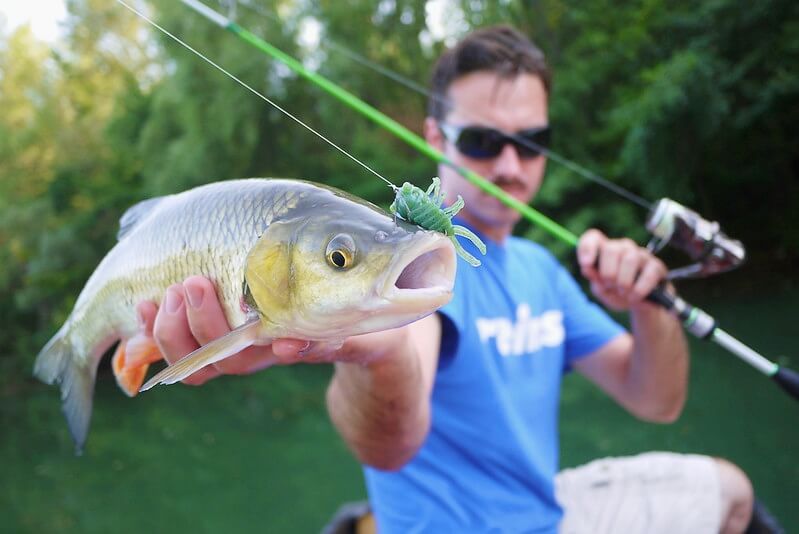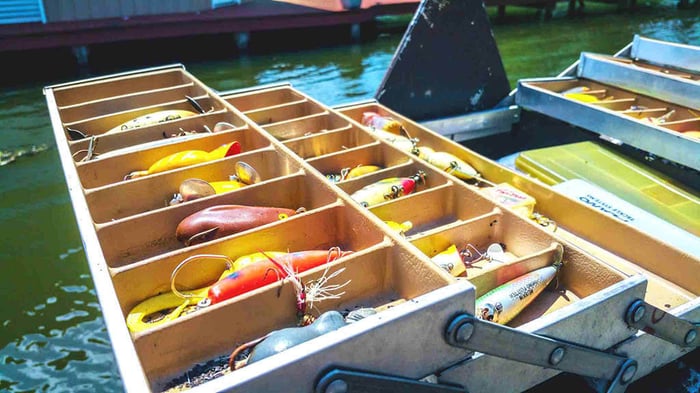Fishing lures are one of the most common ways to attract and catch a fish in your line. They are small, artificial objects usually shaped like a fish's prey connected to a hook and tied to the end of a fishing line. Anglers typically have a tackle box brimming with lures of varied shapes, colors, and designs. They are challenged against which lure to pick on every fishing trip. But, the choice of lure color isn't about what looks excellent to you. The selection will rely upon how fish see a specific color given their environment. But do fishes see colors? All the more, does the color matter?
Does Lure Color Matter?
 There are many different types of lures on the market. When you visit your local tackle shop, everything's made from rubber, plastic, metal, or a combination of such materials. Fishing lures are usually weighted and use a mix of movements, vibrations, colors, and shiny reflections to attract fish to bite. Thus, the color matters (the line's color, too), depending on the depth and how fish see. Apart from imitating prey objects practically, different lures play in the line of vision of fish associated with specific colored lures at different depths, water speeds, and light accessibility. The idea of color attraction and accessible light at different depths is the reason for using red-colored lines. Regardless of color, reflective lures will give flicker and visibility even in deep waters. Remember that clear waters allow light to penetrate further, so your lure's color will stay apparent longer.
There are many different types of lures on the market. When you visit your local tackle shop, everything's made from rubber, plastic, metal, or a combination of such materials. Fishing lures are usually weighted and use a mix of movements, vibrations, colors, and shiny reflections to attract fish to bite. Thus, the color matters (the line's color, too), depending on the depth and how fish see. Apart from imitating prey objects practically, different lures play in the line of vision of fish associated with specific colored lures at different depths, water speeds, and light accessibility. The idea of color attraction and accessible light at different depths is the reason for using red-colored lines. Regardless of color, reflective lures will give flicker and visibility even in deep waters. Remember that clear waters allow light to penetrate further, so your lure's color will stay apparent longer.
Up to 20 feet
All colors will slowly dull as they go from shallow to deep water, yet warm colors like red and orange are the first colors to blur. To a fish, lures in these colors will stay vibrant up to around 20 feet down, however, at that point, their visibility will lower.
20 to 35-45 feet
Orange is the following color to blur. Bright crayfish and orange fire tiger patterns will do nicely until around 40 feet or more.
50 to 75 feet
This is where yellow lures will start losing their vibrant attraction, so you must change the color patterns.
Deeper than 100 feet
Blue and green lures will stay clear as deep as the light enters the water. However, the opposite happens in waters with current, and blue or green lures lose visibility first.
Consider how fish eyes work besides what light and water depth mean for attracting a lure's color pattern. A fish's retina contains two kinds of cells: cones and rods. The cones are used mostly during the day and can perceive color, while the rods are used for seeing around evening time. Considering that they can see light, they can't do likewise for colors.
What is the Best Color for Fishing Lures?
 The first rule of thumb in choosing the best color for fishing lures is to match the water. Very few individuals know about it, but picking the right fishing lure color is essential. Match the color of the water and environmental elements, which will draw fish to your lure.
The first rule of thumb in choosing the best color for fishing lures is to match the water. Very few individuals know about it, but picking the right fishing lure color is essential. Match the color of the water and environmental elements, which will draw fish to your lure.
For instance, please don't use a white lure in muddy waters as fish seldom depend immediately on sight attack; instead, they get their sense from movement in the water and the vibrations of the lure going through the water.
This is the thing that will draw in a fish to your lure. When a fish has visual contact with a lure, they evaluate if it has something to eat or something unfamiliar. If you are using a white lure in brown-colored water, it is simpler for the fish to see the draw before it tries to bite it and see something odd in how it looks and will generally leave the attack.
Therefore, very much like hunting, fishing requires a camouflage method. To destroy the ability of the fish to distinguish your lure as being something unfamiliar, match the lure to the water tone and environmental factors.
The information below explains how to get a blind reaction strike (lure a fish into attacking dependent upon lure movement detected in the water) using different colored lures, usual color mixes, and the conditions they are generally fit to.
Black Fishing Lures
Black fishing lures are best for night fishing in clear waters with no direct moonlight throwing over the water. The reason for this is that fish are already in darkness. Thus, any color other than black or dark brown will appear awkwardly.
Brown Fishing Lures
Brown fishing lures are ideal in muddy water with zero visibility. The reason behind this is that the fish will detect the lure in the water, but since the lure is brown like the water, most fish will hit a brown lure in brown water with zero visibility, more so than any other fishing lure tone.
Green Fishing Lures
Green fishing lures are best when the reflections of the encompassing trees are projecting a green reflection over the water. When the fish is looking through the water segment, it sees green tones from the reflection of vegetation. Using green fishing lure in waters with a bit of or complete visibility, given the encompassing trees are green and most of the reflection on the water is green, is your ideal approach to draw in a fish to your fishing lure.
Yellow or Orange Fishing Lures
Yellow fishing lures are great for the water's clear or slightly murky conditions. However, it has 100% direct sunlight and a solid yellow or orange reflection falling off the surface. This is because the fish will be blinded by the immediate sunlight and will seem yellow or orange to the fish. This will mimic your lure and end up with more fish biting your lure.
Blue Fishing Lures
Blue fishing lures are great for use in conditions where the water has a slight or solid blue color. For the most part, Clear deep waters cast an excellent slightly dark blue tone, while more shallow waters will be a light blue. Very deep, clear waters, like the ocean, can make a much darker blue appearance. Waters like lakes likewise acquire a blue tone due to depth or reflecting the sky above. Match the blue color of your lure to the shade of blue you see yourself in, and watch more fish hitting on each trip.
Red Fishing Lures
Red fishing lures can function admirably in the direct sun, but they are essentially a visual draw. Red lures are frequently used to mirror fish in the water with red fins or cause the fish to notice the draw. They can also function admirably as a reaction lure alone at sunset when the sky turns orange or red.
Gold or Silver Fishing Lures
Silver fishing lures are a little different in that they ought to be used in waters where other fish of a silver color are found. Silver and gold tones frequently copy a genuine fish and depend upon your catch accepting what it sees instead of following up on instincts alone.
White Fishing Lures
White fishing lures are ordinarily perfect for splendid crisp mornings with a ton of white cloud reflection on the water, yet can likewise function admirably as a sight attack if other silverfish are known to lurk in the water.
What are these types of Lures?
Top Water
Poppers, buzz baits, spooks, and whopper poppers are usually used in the summer and drop to mimic shad. They work best in low-light conditions, and it is one of the best times to get a fish to bite. They are ideal to use on shallower rocky points and shallow pads.
Crankbaits
Crankbaits are perfect in depth from 2-25 feet. They are one of the most famous lures to use and are great all year. They are likely the least demanding lure to use for a beginner since you can toss them essentially anyplace and presumably catch a fish.
Swimbaits
Swimbaits are mainly used as a more crafty variety of crankbait. They are used most in the colder time of year and the late spring, and they work best in more clear water. Mostly, they are used in deep water yet can be fished at any water depth.
Worms
Worms, like crankbaits, are best to use all year and can be fished in any depth range. They differ enormously in size and color. However, a 7-inch purple or green pumpkin worm will get fish regardless of the conditions are. Worms are an incredible lure to use in case you are simply starting the game.
Jigs
There is a wide range of jigs with various usage, yet ordinarily, they can be used alternately with worms. They usually will get greater fish than worms. However, they typically don't get as many fish as worms do.
Frogs
Frogs are often used in rising vegetation. They are nice to toss in thin grass that isn't adequately thick to flip. Frogs are typically used throughout the late spring and the fall, and it is an entertaining approach to getting fish.
Choose Your Lure Color and Reel In!
 Realizing which lure to choose for the day will determine whether you have a great day or less than ideal. There are many lures in various sizes and colors, and they all have a spot for catching fish. Each one can be used with multiple gears and cast and fished in several types of cover.
Realizing which lure to choose for the day will determine whether you have a great day or less than ideal. There are many lures in various sizes and colors, and they all have a spot for catching fish. Each one can be used with multiple gears and cast and fished in several types of cover.
The lure color pattern with whites and white patterns appears the best in clear and low permeability conditions. But keep in mind that lure action is enormously significant. When deep jigging, pick whites, blues, and greens and present an action that makes your lure the most recognizable since the fish might be stressed to see it.
But even after thinking about the water clarity, weather conditions, and water depth, you will, in any case, need to adjust to the spot and how the fish are acting on the day. Apply these ideas on your lures, and bet you will land more fish!
























